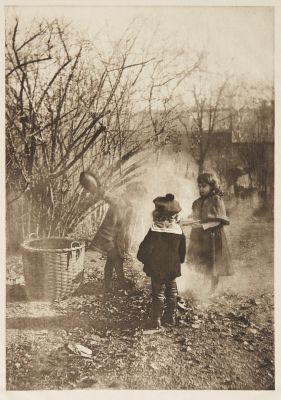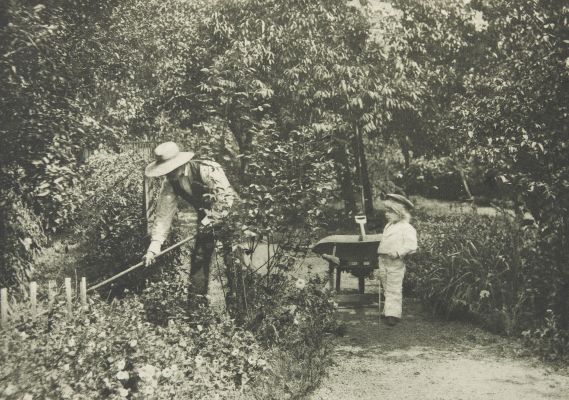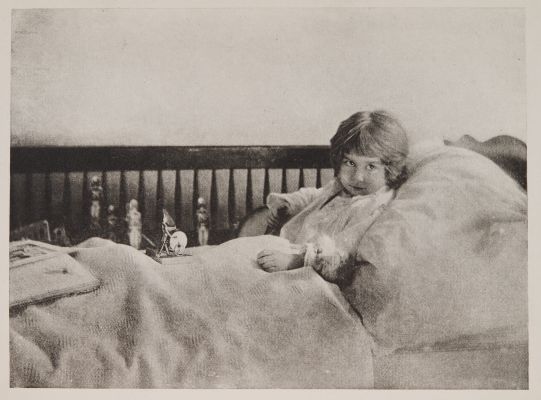
Title
“Don’t You Want this Orange?”Artist
Farnsworth, Emma J. (American, 1860-1952)Publication
Little Lad JamieDate
1895Process
PhotogravureImage Size
16.6 x 11.7 cm
Emma Justine Farnsworth was born on October 16, 1860, in Albany, New York, where she lived her full ninety-one-year life. Her father was a successful lumber merchant and Emma never married. Farnsworth, who had modest art training, received a camera outfit as a gift one Christmas and began to use it the following summer. The earliest known record of her exhibiting photographs is the second Joint Exhibition of 1888, where three of her pictures were seen. Over the next five years, she also was successful in two newspaper competitions. Her work consisted primarily of genre scenes and figure studies.
Early on, Farnsworth took to illustrating books with her sentimental photographs. In 1892, In Arcady appeared, featuring six tipped-in photogravures printed on tissue, picturing classically draped women in the open air, with birds, harps, and children. This thin, but large-scale volume includes verse by the ancient Greek poet Anacreon and others, selected by Farnsworth. Two other titles with images by her were published—both children’s books, also using tissue gravures tipped onto the pages. In 1893, E. P. Dutton and Company issued William Croswell Doane’s Sunshine and Play-Time, which prominently credited Farnsworth on both the cover and title page. Her images, which were paired with Doane’s verses, show children pursuing leisure time activities such as swinging and gardening. Two years later, the same publisher put out Little Lad Jamie, a story by Mary D. Brine, with the very same set of eight photogravures, but no acknowledgment of their maker.
Farnsworth drew the attention of Alfred Stieglitz. In 1893, she once again showed in the Joint Exhibition, organized by the country’s three leading camera clubs (in New York, Philadelphia, and Boston) and was the only woman to win a medal, prompting Stieglitz to consider her the country’s strongest lady amateur. In 1897, her work comprised the second in an important series of solo exhibitions presented by the Camera Club of New York, of which Stieglitz was a leading member. And three years later, he included an image by her as a photogravure in the January 1900 issue of Camera Notes, printed in brilliant orange ink.
Farnsworth’s pictures were reproduced most frequently during the 1890s. They appeared in the American Amateur Photographer (1893, 1899), Photographic Times (1891, 1892, 1896, 1899, 1900), and Sun and Shade (1893). They were included in two deluxe portfolios of photogravures, issued on the occasion of Berlin’s annual International Exhibition of Amateur Photography in 1896 and 1897. Two years later, the Camera Club of New York also featured one of her gravures in its portfolio American Pictorial Photography I.
After the 1893 Joint Exhibition, Farnsworth continued to exhibit through the decade. She showed at the World’s Columbian Exposition (Chicago), Hartford Camera Club, Toronto Camera Club, Royal Photographic Society, and in photographic salons in London, Paris, Pittsburgh, and Washington, D.C. In 1900, Francis Benjamin Johnston included her in the important show American Women Photographers, presented at the Paris Exposition. Shortly before this show, Farnsworth wrote to Johnston that she had largely stopped photographing, but was proud of the more than twenty-five medals she had earned, at exhibitions in Canada, England, France, Germany, Italy, India, and the United States. Johnston, after returning from Paris, included Farnsworth in the series of articles she wrote on "The Foremost Women Photographers in America," for Ladies’ Home Journal (August 1901). Her pictures appeared only sporadically after 1900. They were last seen in exhibitions in 1912, at a Kodak competition in New York and at the Sweat Memorial Art Museum in Portland, Maine.
By 1915, Farnsworth had turned her attention to helping people in Europe adversely affected by World War I. The New York Times reported that she was chairman of the Women’s Section of the Commission for Relief in Belgium, which made Albany its New York State headquarters. She died of cardiac failure, on January 23, 1952. [1]
References
[1] Christian A. Peterson Pictorial Photography at the Minneapolis Institute of Arts (Christian A. Peterson: Privately printed, 2012







